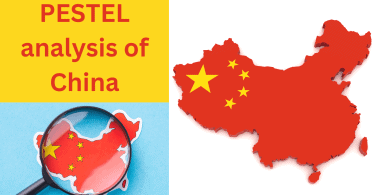In 2024, Canada will remain a key player in the global economy, attracting attention for its stable political environment, robust economic performance, and rich natural resources.
However, like all nations, it faces a dynamic landscape shaped by external and internal factors. A comprehensive PESTEL analysis (Political, Economic, Social, Technological, Environmental, and Legal) offers critical insights into the forces influencing Canada’s macroeconomic environment in 2024.
This analysis will provide a detailed overview of the challenges and opportunities shaping Canada’s future, helping businesses, investors, and policymakers make informed decisions.

Political environment
The Canadian political environment presents both opportunities and challenges for investors. Here’s a detailed breakdown of some key areas:
Opportunities:
Canada’s political climate offers several opportunities for investors. Here are some key areas:
Stable Political Environment
- Democratic Stability: Canada has a stable democratic system with a long history of peaceful power transfers. This provides a predictable and secure environment for businesses.
- Rule of Law: The strong rule of law in Canada ensures that businesses operate within a predictable legal framework.
Pro-Business Policies
- Tax Incentives: The Canadian government offers various tax incentives and credits to encourage investment, particularly in sectors like research and development, clean technology, and manufacturing. For example, the Scientific Research and Experimental Development (SR&ED) program provides tax credits for eligible research and development activities.
- Trade Agreements: Canada is a signatory to several trade agreements, including the Comprehensive and Progressive Agreement for Trans-Pacific Partnership (CPTPP) and the Canada-European Union Comprehensive Economic and Trade Agreement (CETA). These agreements provide preferential market access to Canada’s goods and services in various countries.
Government Support for Innovation
- Research and Development Funding: The Canadian government provides significant funding for research and development activities through agencies like the National Research Council (NRC) and the Canadian Institutes of Health Research (CIHR). This support fosters innovation and competitiveness.
- Start-up Ecosystem: Canada has a thriving start-up ecosystem with government initiatives like the Startup Visa Program that facilitates immigration for entrepreneurs.
Focus on Sustainability
- Green Initiatives: The Canadian government has significantly invested in clean energy and sustainable practices. This presents opportunities for businesses in sectors like renewable energy, green technology, and sustainable agriculture.
- Environmental Regulations: Canada’s environmental regulations, while stringent, can also create opportunities for businesses to develop innovative solutions to environmental challenges.
Multiculturalism and Diversity
- Global Talent: Canada’s multiculturalism attracts a diverse pool of talent worldwide. This can benefit businesses by providing access to a skilled workforce with various perspectives.
- Diverse Markets: Canada’s diverse population creates a market with varying tastes and preferences, offering opportunities for businesses to cater to different segments.
Threats:
While Canada generally has a stable political environment, investors should be aware of potential threats. One issue is the divergence between provincial and federal policies, which can create regulatory challenges for businesses nationwide.
Variations in environmental regulations, labour laws, and taxation can increase operational complexity and costs. Additionally, policy changes at either level of government may introduce uncertainty.
Resource nationalism is another risk, particularly in sectors like mining and energy. There have been instances where governments impose stricter regulations, increase taxes, or even expropriate assets.
Indigenous rights and reconciliation present further challenges. Ongoing legal negotiations and community opposition can affect resource development and infrastructure projects, leading to delays, increased costs, and reputational risks.
Lastly, trade disputes pose a threat, as growing global protectionism can harm Canadian exports and investments. Tariffs imposed by trading partners also raise the cost of Canadian companies doing business.
Economic environment
In 2024, Canada’s economy is showing signs of resilience. While there have been challenges related to inflation and interest rates, the overall outlook remains positive.
Key Economic Indicators
Inflation rates have been trending downward, although they remain higher than historical averages. The Bank of Canada has gradually raised interest rates to combat this inflation. Unemployment remains low, indicating a strong labour market.
While economic growth has continued, it is at a slower pace compared to previous years. The Bank of Canada’s interest rate hikes affect consumer and business borrowing costs. Meanwhile, the housing market is cooling, with prices stabilizing in certain areas.
Challenges and Opportunities
Inflation is a significant challenge as it erodes purchasing power and leads to higher interest rates. Rising interest rates themselves also impact borrowing costs and overall economic activity.
Global economic uncertainty, driven by geopolitical tensions and supply chain disruptions, adds further risk to the economy. However, Canada’s transition to a low-carbon economy presents challenges and opportunities for growth and job creation.
While Canada’s economy is positioned for continued growth, it faces hurdles related to inflation, interest rates, and global uncertainty. Successfully navigating these challenges will be vital in determining its future economic prospects.
Social environment
Canada’s social and cultural landscape is shaped by diversity, multiculturalism, and a commitment to equity and inclusion, all of which influence the business environment and consumer preferences.
Key Elements and Their Impact
Canada’s diverse and multicultural population, enriched by significant immigration, allows businesses to cater to a wide range of consumer needs by embracing diversity.
Ongoing Indigenous reconciliation efforts shape social attitudes, and businesses that engage meaningfully with Indigenous communities contribute to positive change.
Environmental consciousness is growing, with Canadians favouring sustainable products and practices, providing opportunities for businesses to prioritizez sustainability.
Technological advancements and a strong focus on innovation help companies improve efficiency and enhance customer experiences. Social media also plays a significant role in shaping consumer behaviour, making digital engagement vital.
Canadians’ increasing emphasis on work-life balance encourages businesses to prioritize employee well-being while understanding regional differences across Canada, which allows companies to tailor their offerings to local cultures.
Implications for Businesses
Businesses can succeed by creating inclusive workplaces, adopting sustainable practices, and embracing digital technologies, including social media. Flexible work arrangements improve employee satisfaction, while cultural sensitivity toward regional differences fosters more robust relationships with customers and communities.
Technological environment
Canada’s technological macro environment offers opportunities and challenges, as the country boasts a robust infrastructure and growing innovation hub status.
Opportunities
Canada has a highly skilled workforce, particularly in STEM fields, which attracts technology companies. The government provides various incentives and programs to support innovation and technological development.
Canada’s research and development ecosystem fosters cutting-edge advancements, with the country positioned at the forefront of emerging technologies like artificial intelligence, clean energy, and biotechnology.
The robust digital infrastructure, including broadband internet and data centers, supports technological growth.
Threats
Cybersecurity risks increase with advancing technology, posing a significant challenge in protecting sensitive data and infrastructure. The digital divide, especially in rural areas, presents issues in providing equitable access to technology.
Rapid technological change makes it difficult for businesses to adapt quickly. Global competition in the technology sector remains intense, requiring Canadian companies to stay innovative. Finally, navigating complex privacy and data protection regulations is a persistent challenge.
Potential Impact on Businesses
Technological advancements can increase business efficiency and create opportunities for new business models and revenue streams.
Technology also enhances customer experience through personalized services and digital channels, offering a competitive advantage for companies that can effectively leverage it.
However, adapting to these changes can be costly, and cybersecurity risks demand significant investment to protect data and reputation.
To thrive in Canada’s technological macro environment, businesses should:
Invest in research and development to stay ahead, embrace digital transformation to improve operations, prioritize cybersecurity to protect sensitive data, build a skilled workforce through training, and collaborate with partners in the industry, research, and government sectors to drive innovation.
Ecological environment
Canada’s vast and diverse ecological landscape offers significant business opportunities and challenges.
Opportunities
Canada’s abundant natural resources, such as forests, minerals, and renewable energy sources, provide numerous economic opportunities. Fueled by the country’s natural beauty, environmental tourism attracts millions of tourists each year, boosting the tourism sector.
The growing focus on sustainability has created opportunities for businesses offering eco-friendly products and services. Canada’s potential for renewable energy, including hydropower, solar, and wind power, presents economic and environmental benefits.
Additionally, businesses that develop solutions for climate change mitigation can benefit from government incentives and market demand.
Threats
Climate change presents severe risks to Canada’s ecosystems, including rising sea levels, extreme weather events, and changes in biodiversity.
Overexploitation of natural resources can lead to depletion and environmental degradation. Strict environmental regulations, while necessary, can increase costs for businesses, particularly in resource-heavy industries.
Natural disasters like wildfires and floods can disrupt economic activity and infrastructure. Furthermore, biodiversity loss can negatively impact ecosystems and industries that rely on natural resources.
Potential Impact on Businesses
Environmental regulations and climate change mitigation efforts can increase operational costs. Companies that negatively impact the environment risk damaging their reputation and facing consumer backlash. However, businesses that adopt sustainable practices can gain a competitive advantage.
The transition to a low-carbon economy offers innovation opportunities for companies developing new products and services. Regulatory risks, including changes in environmental laws, can introduce uncertainty and affect business operations.
Canadian businesses can contribute to a sustainable and prosperous future by addressing these opportunities and challenges.
Legal environment
Canada’s legal macro environment is generally stable and predictable, offering business opportunities but presenting specific challenges.
Opportunities
Based on British common law, Canada’s legal system is known for its predictability and fairness. The country has strong intellectual property protection laws, safeguarding inventions, trademarks, and copyrights.
Business-friendly regulations create a conducive environment for enterprises, and efficient dispute resolution mechanisms, such as courts and arbitration, allow businesses to resolve conflicts effectively.
Additionally, Canada’s participation in international trade agreements opens global market access and reduces business trade barriers.
Threats
Despite its stability, Canada’s legal system can be complex, with businesses needing to navigate federal, provincial, and municipal regulations.
The regulatory landscape constantly evolves, and new laws and regulations require businesses to stay informed and adapt.
Legal disputes can be time-consuming and costly, while cybersecurity risks pose significant legal and financial threats. International trade disputes and protectionist policies can also affect Canadian businesses operating in global markets.
Potential Impact on Businesses
Compliance with legal regulations can increase operational costs. Non-compliance may lead to fines, penalties, and legal disputes, impacting a company’s reputation and operations.
However, businesses that successfully navigate the legal landscape can gain a competitive advantage. Additionally, changes in the legal framework may present innovation opportunities for companies to develop new products or services.
Recommendations
Businesses should ensure full legal compliance, seek expert legal counsel, stay updated on changes in laws and regulations, and develop risk management strategies to mitigate legal risks and manage potential disputes. For those operating in international markets, seeking advice on foreign laws and regulations is crucial.
Conclusion
Canada in 2024 presents a wealth of opportunities, particularly in sectors such as technology, renewable energy, and natural resources, thanks to its stable political environment, advanced infrastructure, and commitment to sustainable development.
However, the country also faces significant threats, including economic uncertainty due to global inflation, environmental challenges linked to climate change, and shifting legal regulations around trade and industry.
Conducting a PESTEL analysis highlights both the strengths and vulnerabilities of Canada’s macro environment, illustrating why a deep and detailed market study is crucial for businesses and investors.
Understanding the political terrain, economic trends, social dynamics, technological advancements, environmental challenges, and legal shifts enables stakeholders to make informed decisions, mitigate risks, and capitalize on emerging opportunities.
In today’s dynamic global market, a well-researched approach is essential for successfully maneuvering through the complexities of investing in Canada.
PESTEL analysis examples 2024
To better understand the PESTEL analysis, we invite you to read our recent free examples of the Pestel framework.
PESTEL analysis of Asda
Click here to read our example of Asda PESTEL analysis.
PESTEL analysis of Tesco
Click here to read our example of Tesco PESTEL analysis.
PESTEL analysis of Lululemon
Click here to read our example of Lululemon PESTEL analysis.
PESTEL analysis of China
Click here to read our example of China PESTEL analysis.
PESTEL analysis of Coca-cola
Click here to read our example of Coca-cola PESTEL analysis.
PESTEL analysis of British Airways
Click here to read our example of British Airways PESTEL analysis.
PESTEL analysis of Primark
Click here to read our example of Primark’s PESTEL analysis.
PESTEL analysis of Zara
Click here to read our example of Zara’s PESTEL analysis.
PESTEL analysis of DHL
Click here to read our example of DHL’s PESTEL analysis.
PESTEL analysis of FedEx
Click here to read our example of FedEx’s PESTEL analysis.
PESTEL analysis of Chipotle
Click here to read our example of Chipotle’s PESTEL analysis.
PESTEL analysis of Brazil
Click here to read our example of Pestel’s analysis of Brazil.
PESTEL analysis of Spotify
Click here to read our example of Spotify Pestel analysis.
Chick-fil-A PESTEL Analysis
Click here to read our example of Chick-fil-A Pestel analysis.
Costco PESTEL Analysis
Click here to read our example of Costco Pestel analysis.
Microsoft PESTEL Analysis
Click here to read our example of Microsoft Pestel analysis.
Disney PESTEL Analysis
Click here to read our example of Disney Pestel analysis.
Airline Industry PESTEL Analysis
Click here to read our example of the Airline industry Pestel analysis.
Walmart Pestel Analysis
Click here to read our example of Walmart Pestel analysis.
Amazon Pestel Analysis
Click here to read our example of Amazon Pestel analysis.
McDonald’s Pestel Analysis
Click here to read our example of the Netflix Pestel analysis.
Netflix Pestel Analysis
Click here to read our example of the Netflix Pestel analysis.
Apple Pestel Analysis
Click here to read our example of the Apple Pestel analysis.
Twitter Pestel Analysis
Click here to read our example of the Twitter Pestel analysis.
Facebook Pestel Analysis
Click here to read our example of the Facebook Pestel analysis.
Pestel analysis of the Social Media industry
Click here to read our example of the Pestel analysis of the Social Media industry.
Ikea Pestel Analysis
Click here to read our example of the IKEA Pestel analysis.
Tesla Pestel Analysis
Click here to read our example of the TESLA Pestel analysis.












Leave a Comment